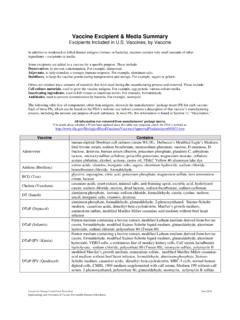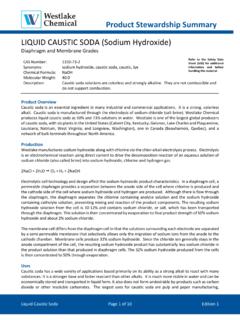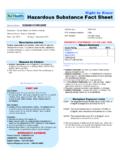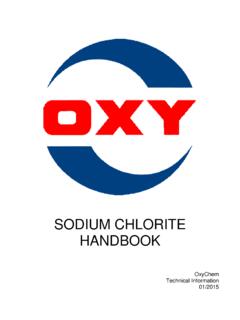Transcription of ACIDIFIED SODIUM CHLORITE (ASC) Chemical and Technical ...
1 ACIDIFIED SODIUM CHLORITE (ASC). Chemical and Technical Assessment Prepared by Madduri V. Rao, for the 68th JECFA. 1. summary At the 68th meeting of JECFA, the safety of ACIDIFIED SODIUM CHLORITE (ASC) for use as a surface- treatment antimicrobial agent was evaluated. This Chemical and Technical Assessment summarizes data and information on the ACIDIFIED SODIUM CHLORITE as submitted to the 68th JECFA by Ecolab Inc., USA, in the dossier dated December 2006. ASC possesses antimicrobial properties and is intended for use primarily as a spray or a dipping solution for poultry, meats, vegetables, fruits and sea foods. It is also used in poultry chilling water. ASC is produced by the addition of a food-grade acid ( , citric acid, phosphoric acid, hydrochloric acid, malic acid, or SODIUM hydrogen sulfate) to an aqueous solution of SODIUM CHLORITE (NaClO2). Combining the acid with SODIUM CHLORITE solution results in conversion of CHLORITE to metastable chlorous acid (HClO2), which can subsequently form a mixture with CHLORITE (ClO2), chlorine dioxide (ClO2) and chloride (Cl ).
2 The reaction, therefore, generates an oxidative solution with oxy-chlorine species with antimicrobial properties. ASC is intended for use as a part of an integrated approach designed to control microbial loads on food stuffs. ASC solution acts to reduce the number of pathogens ( , Escherichia coli, E. coli O157:H7, Salmonella spp., Campylobacter spp., and Listeria monocytogenes), as well as to a somewhat lesser extent, spoilage bacteria found on the surface of foods during processing. The solution is applied onto the surface of different types of fresh and processed foods at a concentration range of 50 to 1200. mg/l. Fresh and processed fruits and vegetables are subjected to a water rinse after ASC application followed 24-hour withholding time (for cut produce only). Treatment of whole or parts of poultry carcass, sausages or deli meats is carried out by spraying or dipping prior to or after chilling.
3 ASC is also used to treat pre-chilling and chilling water at relatively low levels ( , 50 to 150 mg/l) into which poultry carcasses are submerged. Poultry and meat products are not subjected to rinse subsequent to treatment. SODIUM CHLORITE used in the preparation of ASC has not previously been evaluated by the Committee. Among the acids mentioned above that may be used in the preparation of ASC, SODIUM hydrogen sulfate has not been evaluated by the Committee. 2. Description SODIUM CHLORITE [CAS No. 7758-19-2] is marketed in two forms, as a solid characterized by approx. 80%. SODIUM CHLORITE and as an aqueous solution. SODIUM CHLORITE is soluble in water, insoluble in non-polar solvents, and sparingly soluble in polar solvents (Merck, 2001). Aqueous solutions are colourless to greenish yellow and exhibit a slight chlorine-like odour. While the CHLORITE ion is stable in aqueous solution, under acidic conditions, CHLORITE forms a semi-stable intermediate, chlorous acid (HClO2).
4 Chlorous acid disintegrates to chlorine dioxide (ClO2), which further degrades to CHLORITE (ClO2 ) and ultimately chloride (Cl ) is formed. The extent of each of the degradation pathways and thus the proportion of each of the oxy-chlorine species depends in part on the pH of the solution. Other factors such as temperature and alkalinity of the water also affect the composition of the oxy-chlorine constituents. At a pH in the range of , chlorous acid (5 to 35%) is the main active ingredient produced by the reaction and is in equilibrium with H+ and the CHLORITE ion (ClO2 ) (65-95%). +. NaClO 2 + H HClO 2. ACIDIFIED SODIUM CHLORITE (ASC) (CTA) 2007 - Page 1(12). Concentrations of chlorous acid and its degradation products are determined by the pH, temperature, and acid/base concentrations of the solution. Sufficient food-grade acid is used to maintain a pH between and and sufficient Technical -grade SODIUM CHLORITE is used to produce a to solution (500- 1200 ppm).
5 Among the different applications, the highest concentration of chlorous acid is attained at a pH of in 1200 ppm ASC solution. At a pH of , approximately 31% of CHLORITE (from SODIUM CHLORITE ) is converted to chlorous acid and 10 and 6% at pH and , respectively. Concentrations of chlorous acid found in ASC solutions with different pH levels are summarized in Table 1. Table 1. Concentration of chlorous acid (ppm) in solutions of ACIDIFIED SODIUM CHLORITE (ASC). with different CHLORITE concentrations and pH levels Concentration of SODIUM CHLORITE pH. 50 ppm 150 ppm 500 ppm 1200 ppm 16 - 157 376. 6 19 - - 5 - 51 123. 3 8 - - Since different acids have varying buffering capacities, the acidity of the solution is dependent on the particular acidulant used to acidify SODIUM CHLORITE . The pH values at different concentrations of citric acid, phosphoric acid, and SODIUM hydrogen sulfate to prepare a 1000 mg/l SODIUM CHLORITE solution are presented in Figure 1.
6 Figure 1. pH curves for citric acid, phosphoric acid and SODIUM hydrogen sulfate ( SODIUM bisulfate) to prepare a 1000 mg/l SODIUM CHLORITE solution pH Curves of Varying Acids pH. % Acid SODIUM Bisulfate Phosphoric Acid Citric Acid SODIUM CHLORITE is largely used in the disinfection of water. It is also used, in substantial amounts, in the production of chlorine dioxide for applications such as bleaching of textiles, in the processing of pulp and paper (IARC, 1991). Accordingly, drinking water and occupational exposure are primary sources of SODIUM CHLORITE in the environment. In the United States, 7700 tonnes of SODIUM CHLORITE (80% purity). ACIDIFIED SODIUM CHLORITE (ASC) (CTA) 2007 - Page 2(12). was manufactured in 1991 (Kaczur & Cawlfield, 2001). In European countries, annual production volumes in the range of 1500 to 10000 tonnes were reported. 3. Method of Manufacture SODIUM CHLORITE Commercially, SODIUM CHLORITE is manufactured via Chemical or electrochemical reduction of SODIUM chlorate to chlorine dioxide gas (IARC, 1991; ATSDR, 2004).
7 Chlorine dioxide dissolved in aqueous SODIUM hydroxide is subsequently reduced with hydrogen peroxide to form SODIUM CHLORITE . The resulting solution contains SODIUM CHLORITE at concentrations ranging from 30 to 50% and dried to a solid characterized by a SODIUM CHLORITE content of ca. 80% or diluted to an aqueous solution. More specifically, SODIUM chlorate, which is obtained by electrolytic oxidation of SODIUM chloride, is reduced electrochemically in the presence of hydrochloric acid to chlorine dioxide and chlorine, with SODIUM chloride formed as a by-product ( SODIUM chloride is recycled to form SODIUM chlorate). Alternatively, chlorine dioxide is obtained by reacting together SODIUM chlorate, hydrogen peroxide, and sulphuric acid according to the following: 2 NaClO3 + H2O2 + 2H2SO4 2 ClO2 + 2 NaHSO4 + O2 + 2H2O. Subsequently, chlorine dioxide is absorbed in a solution of SODIUM hydroxide and hydrogen peroxide to form a SODIUM CHLORITE solution according to the following: 2 ClO2 + 2 NaOH + H2O2 2 NaClO2 + O2 + 2H2O.
8 Sulphuric acid can be used to neutralize any excess alkali and the resulting SODIUM CHLORITE solution can be drum-dried to form solid SODIUM CHLORITE . The dried product is adjusted to contain at least 79% of SODIUM CHLORITE by addition of SODIUM chloride, SODIUM sulphate, or SODIUM carbonate. Instead of producing a solid product, the resultant SODIUM CHLORITE solution also can be diluted to a 25% solution. SODIUM Hydrogen Sulfate SODIUM chloride and sulfuric acid are the starting materials in the manufacture of SODIUM hydrogen sulfate. Natural salt is first dissolved in water and then re-crystallized to produce a refined salt. Sulfuric acid is obtained from the roasting of natural sulfur-containing ores, resulting in the production of sulfur oxides that are dissolved in water to produce sulfuric acid. The SODIUM chloride and sulfuric acid are combined at elevated temperatures to produce molten SODIUM hydrogen sulfate according to the following reaction: Heat NaCl + H 2SO4 NaHSO 4 + HCl Once the reaction is complete, the molten SODIUM hydrogen sulfate is sprayed and cooled to form a solid product of consistent particle size.
9 Other Acids (Citric acid, phosphoric acid, hydrochloric acid and malic acid). Manufacturing of the above acids are not included in this CTA as they have been previously evaluated by the JECFA. Appropriate JECFA specifications may be consulted for their manufacturing processes. ACIDIFIED SODIUM CHLORITE (ASC) (CTA) 2007 - Page 3(12). ACIDIFIED SODIUM CHLORITE ASC solutions are prepared just prior to use. SODIUM CHLORITE and acids used in the preparation of ASC. are stored either in bulk as concentrates or as formulated solutions. When stored as bulk concentrates, the individual components are diluted with water to a double-strength solution before mixing. The acid and base solutions, whether stored as such or diluted from concentrates at the site of mixing, are combined in a 1:1 ratio. Once mixed, the solution is applied within one to two minutes. The amount of food-grade acid that needs to be added to SODIUM CHLORITE in order to achieve a solution with a specific pH and level of chlorous acid depends on the strength of the acid and the buffering capacity of the solution.
10 The alkalinity of the water, although not a primary determinant, also needs to be considered. Thus, weaker acids are added at concentrations of to , whereas stronger acids ( , phosphoric acid) are used at lower concentrations (approximately to ). A strong acid such as sulfuric acid would be added at a concentration of less than 50 g/ml. 4. Characterization Composition of SODIUM CHLORITE The Technical -grade of SODIUM CHLORITE used to prepare ASC is comprised of 80% of SODIUM CHLORITE , with SODIUM chloride, SODIUM carbonate, SODIUM hydroxide, SODIUM sulfate, and SODIUM chlorate making up the remainder of the composition. Possible impurities (including degradation products). SODIUM CHLORITE The manufacturing process employed in the production of SODIUM CHLORITE , does not include any specific purification steps. Impurities occurring in SODIUM CHLORITE comprises of unreacted staring materials ( , SODIUM chlorate) as well as reaction by-products ( , SODIUM chloride).


















